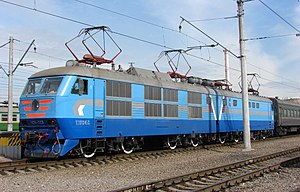SŽD series ЧС6
| SŽD series ЧС6 Škoda type 50E 1 |
|
|---|---|
|
ЧС6 023
|
|
| Numbering: | SŽD ЧС6 001-030 |
| Number: | 30th |
| Manufacturer: | Škoda Plzeň |
| Year of construction (s): | 1979-1981 |
| Axis formula : | Bo'Bo '+ Bo'Bo' |
| Gauge : | 1520 mm |
| Top speed: | 190 km / h |
| Continuous output : | 8000 kW |
| Starting tractive effort: | 420 kN |
| Driving wheel diameter: | 1250 mm |
| Power system : | 3 kV direct current |
| Power transmission: | Resistance control |
| Number of traction motors: | 8th |
| Drive: | Škoda hollow shaft drive |
| Brake: |
DAKO - compressed air brake, electrical resistance brake |
| Locomotive brake: | DAKO compressed air brake |
The SŽD series ЧС6 (German transcription TschS6) of the Soviet Railways (SŽD) is an express train locomotive in two-section design for 3 kV direct current , which arose from the SŽD series ЧС200 and was specially developed for higher tractive forces.
history
In order to guarantee the passability of the SŽD railway lines, the number of trains on the lines should be reduced and at the same time the number of wagons for passenger trains should be increased. These specifications required a new locomotive with more tractive power than the derС200. This electric locomotive was the ЧС6 , which was built in 1979 under the factory designation 50E 1 . Originally, the maximaleС160 series, designed for the maximum speed of 160 km / h, should be named.
The main differences between the new electric locomotive and the previous series ЧС200 are:
- Change of the transmission ratio of the drive system to 79:38 (transmission ratio 2.079 instead of 1.786), which led to a reduction in the maximum speed and at the same time to an increase in the tractive effort;
- Use of other wheel tires;
- other electricity consumers (as with the ЧС2т );
- Elimination of the special ALSH-200 locomotive signaling .
The construction principles of the ЧС6 are identical to those of the ЧС200. There are only minimal differences in the auxiliary services and the operation. The locomotive owns
- a maximum pulling force of 420 kN at a speed of 5 km / h,
- a tensile force in continuous operation of 239 kN and
- a maximum pulling force of 165 kN at a speed of 160 km / h.
In 1979 the first series of ten locomotives was delivered. In 1981 a further 20 locomotives were delivered, which differed from their predecessors in the construction of some devices, the electrical connection between the sections and the design of the second pantograph on the roof. They have the factory designation 50E 2 .
The locomotives were originally intended for operation in the Leningrad P locomotive depot . Some were given to the Tuapse depot , where locomotives with high tractive power were required on the routes in the mountainous region. The use of the vehicles at speeds of around 75 km / h had disadvantages for the locomotives. In this speed range, they did not work effectively in terms of energy. Later all LokС6 locomotives returned to St. Petersburg and were used there on the St. Petersburg - Moscow , St. Petersburg - Helsinki , St. Petersburg - Swir routes.
See also
Web links
- Photo of the ЧС6.011
- Photo of the ЧС6.007
- Photo of the ЧС6.020 on bahnbilder.de
- Collection of images of the ЧС6 on trainspo.com
